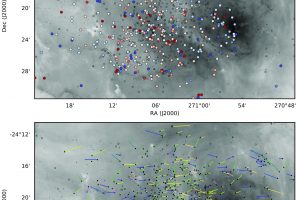Dynamic and expansion of stellar clusters. The study: “The Gaia-ESO Survey: asymmetric expansion of the Lagoon Nebula cluster NGC 6530 from GES and Gaia DR2” of N. J. Wright (Keele University) recently appeared on MNRAS

Despite a significant fraction of stars form in stellar clusters counting hundreds to thousands of members, almost all the stars we observe today in the Milky Way is not associated to any stellar cluster. This occurs because newborn stellar clusters are typically dispersed in a few million of years by several intervening processes, such as the gravitational interaction among cluster members, the explosion of supernovae, the interaction between stellar clusters and nearby nebulae, and the dispersion of the parental cloud. In particular, the latter process results in the reduction of the gravitational field experienced by the stars associated to a cluster. For this reason, several studies suggest that the dissipation of the parental cloud is the leading factor in the dispersion of stellar clusters.
The study of the dynamical evolution of stellar clusters and their dispersion requires accurate measurements of the proper motion (e.g. the stellar motion in the sky) and radial velocity (the motion of the stars along the line of sight), together with an accurate selection of the stars associated with the given stellar cluster. This is feasible today thanks to the Gaia satellite of the European Space Agency. During its mission, in fact, Gaia is providing accurate measurements of position, proper motion, radial velocity, and parallax (from which it is possible to derive the distance) of more than one billion stars in our Galaxy. This will allow astronomers to derive a 6D map (positions+velocities) of the stars of the Milky Way. In order to take full advantage of Gaia mission for the study of stellar clusters, astronomers from several institutions, among which the INAF – Astronomical Observatory of Palermo, defined the Gaia-ESO Survey. This observative campaign provided spectral observations with FLAMES of the European Southern Observatory of stars associated to several stellar clusters. These spectra provide powerful diagnostics of membership of the observed stars to the stellar clusters, together with accurate measurements of stellar radial velocity and other stellar parameters.
The team led by N. J. Wright (Astrophysics Group, Keele University), counting also the astronomers R. Bonito, F. Damiani, G. Micela, and L. Prisinzano of INAF – Astronomical Observatory of Palermo, has analyzed Gaia and Gaia-ESO Survey data of about 900 stars associated with the Lagoon Nebula and its cluster NGC 6530, in order to study its dynamical evolution and dispersion. The team has measured and compared the dispersion velocity of all the stars associated with the Lagoon Nebula and that of only NGC 6530, finding that while the stars associated with the whole Lagoon Nebula form a gravitationally unbound system (with a dispersion velocity of 5.35 km/sec), NGC 6530 was gravitationally bound once (being characterized by a dispersion velocity of 2.75 km/sec). This study also shows that the entire system is expanding with a non symmetric distribution of stellar velocities. The expansion, in fact, is faster along the right ascension axis than along declination. This asymmetry can not result from a dispersion led by the dissipation of the parental cloud, as suggested by several models of clusters evolution. This study, described in the paper “The Gaia-ESO Survey: asymmetric expansion of the Lagoon Nebula cluster NGC 6530 from GES and Gaia DR2” recently appeared on the Monthly Notices of the Royal Astronomical Society journal, suggests thus that several other factors contribute to the dispersion of the stars associated with the Lagoon Nebula.
The figure (link) shows a map of the radial velocity (top panel) and proper motion (bottom panel) of the stars associated with the Lagoon Nebula, plotted over a VPHAS+ Hα image of the Lagoon Nebula.
